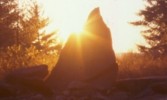|
|
Celtic Theory
This theory was originally proposed by William Goodwin who was the first person to systematically investigate the archaeology of the site. The theory first appears in 1939 in a series of newspaper articles and was eventually formalized in Goodwin’s 1946 book The Ruins of Great Ireland in New England. Goodwin argued it was built by Irish Culdee Monks around 1000 AD. Barry Fell, a Harvard Professor of Marine Biology, and self professed linguist, argued based upon his translations of the various "writings" found at the site that it was built by Iberian Celts between 800 and 400 BC. Fell’s arguments appeared in his book America B.C. (1976). The book proved to be very popular with the American public and was instrumental in introducing the theory to a wider audience. Other researchers have proposed variants of the Celtic Theory.
Problems & Objections
There are some basic problems with this theory. The most logical route for a group of Celts to travel to here would be to island hop from Ireland to Iceland to Greenland to the Canadian coast. The problem is that there is no archaeological evidence that Celts ever made it to Greenland and Iceland let alone North America. Basically, despite years of searching, not a single Celtic grave, shipwreck or habitation site has been found in North America, Iceland, or Greenland. No Celtic artifacts have been found at America’s Stonehenge.
The Celts were made up of different tribes and cultures which shared the same parent language. These tribes spoke different dialects of the Celtic language, lived in different parts of Europe, and at different time periods. When one speaks of the Celts, one needs to be specific about which culture, dialect, and time period which is being discussed. The same applies to linguistic studies. There are a number of different Celtics alphabets each associated with different dialects of the language. These alphabets also changed over time as well. When discussing translations of alleged inscriptions one needs to be linguistically specific.
The references for all the articles on this website are consolidated on the Bibliography page.


